Have you heard about Wi-Fi calling, but not exactly sure how it works? Or, more importantly, how to turn it on? We’ll break down everything you need to know about calling over Wi-Fi for you.
Apple and Android devices support Wi-Fi calling. Without using your phone service provider as the middleman. It’s is a great solution to achieve high-quality calls indoors.
As companies shift their staff to work remotely, you’ll likely get acquainted with Wi-Fi calling and its limitations. The best part is that if you have strong Wi-Fi network coverage, you can communicate with your team using HD Voice over a Cloud-Telefonsystem. Unlike cellular service, HD Voice has much higher quality sound and clarity—a must for any team.
Was ist Wi-Fi-Calling?
Wi-Fi selbst arbeitet nach einer Reihe von Standards, die von IEEE und der Wi-Fi Alliance festgelegt wurden. Wenn Sie über eine Hochgeschwindigkeits-Breitbandverbindung verfügen, haben Sie wahrscheinlich auch einen Router, der diese drahtlose Abdeckung bereitstellen kann.
Typischerweise bietet ein drahtloser Router eine Reichweite von etwa 150 Fuß von seinem Standort, abhängig von Baumaterialien und anderen Faktoren.
Wi-Fi calling gives you the chance to make phone calls using a wireless internet connection. It doesn’t go through a traditional telecommunications provider like AT&T or Verizon. Additionally, Android and iOS devices now have accepted, universal standards (APIs) for VoIP calls in a way that is optimized for battery life and the user experience.
Durchdenken Geschäftskontinuität, it’s important to have a backup connection. If your company’s network connection fails, you need to be able to conduct business over an LTE-based cellular connection. Wi-Fi calling takes place over both when configured correctly.
Einer der Trends, die wir in der entdeckt haben Bericht zur Geschäftskommunikation 2020 ist die positive Einstellung zur Remote-Arbeit. Auch die aktuellen Ereignisse haben diese Verlagerung dahingehend beschleunigt, dass Mitarbeiter außerhalb des Büros arbeiten können. Fast vier von zehn Unternehmen lassen ihre Teams jetzt aus der Ferne arbeiten.
Wie funktioniert WLAN-Calling?
Der einfachste Weg, einen Wi-Fi-Anruf zu tätigen, ist über a VoIP (Voice over Internet Protocol) system. It works by reaching a carrier over the internet connection to establish a phone line. There’s a lot of happening unter der Haube to make this possible, but to you, it’s practically effortless.
Apps wie WhatsApp, Skype und Facebook Messenger VoIP-Technologie verwenden to make calls. With today’s capable devices, you don’t have to do much to achieve a strong network connection. Apps like Nextiva Lassen Sie Unternehmen Wi-Fi-Anrufe von jedem Gerät aus tätigen—even if it doesn’t have a cellular connection (or SIM Card).
Grundsätzlich verwendet Wi-Fi-Anrufe VoIP, um Anrufern ein besseres Anruferlebnis zu bieten. Sie können den passenden Tarif auswählen und Telefonnummer that works for your business. It’s also a great way to skip paying your cellular company high international rates. With modern advances in wireless routers, you leverage them for reliable network connections without any dropped calls.
Wird Ihnen das in Rechnung gestellt?
Traditionally, phone calls made using a cellular connection come from your monthly allowance. The Wi-Fi calling feature is similar. Wi-Fi calls have no additional charge; it’s taken from your monthly voice plan.
It’s a fantastic option for Mitarbeiter, die Telearbeit leisten. You won’t pay sky-high international calling rates for making cross-border calls. You’re einfach mit Daten von Ihrer Erlaubnis, internationale Ferngespräche zu führen. Nur zur Übersicht: Über WhatsApp werden mehr als 100 Millionen Sprachanrufe getätigt jeden Tag.
Der beste Teil? Cisco prognostiziert, dass es bis 2021 542 Millionen drahtlose Netzwerke geben wird Hotspots auf der ganzen Welt, die Wi-Fi-Anrufe unterstützen.
Mit Cloud-Telefondienste like Nextiva people can call as much as they want across the United States, Canada, and Puerto Rico. And when it’s time to call abroad, they can call around the world for as low as a penny per minute.
So aktivieren Sie Wi-Fi Calling auf einem iPhone
Ready to make your first Wi-Fi call? You no longer need old-fashioned apps like Skype. This process works the same on iPhone 6, iPhone 6S, iPhone 7, iPhone X, iPhone XS.
To make a Wi-Fi call on your iPhone, head to your Settings, and hit the Mobile Data option. Here, you’ll see a section for Wi-Fi calling:
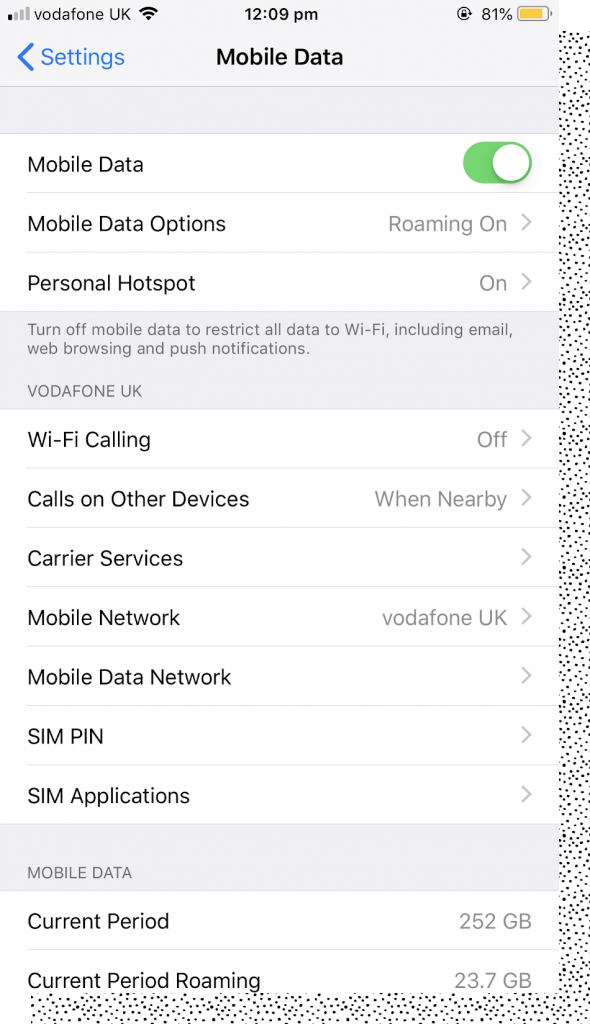
Klicken Sie auf die Schaltfläche und schieben Sie den Schalter für WLAN-Anrufe auf Ein:
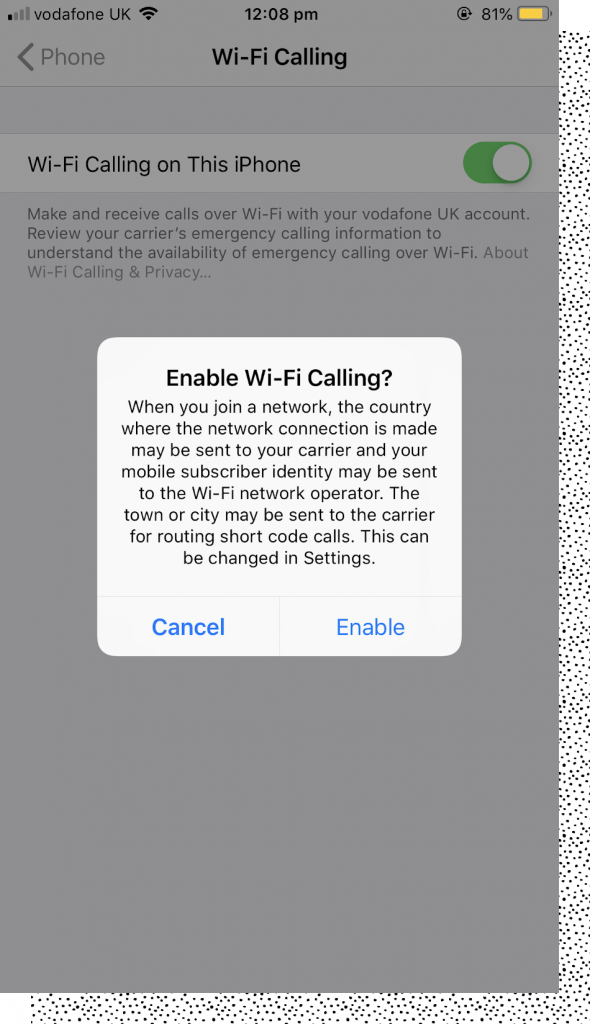
Ihr iPhone ist jetzt bereit für Anrufe über eine Wi-Fi-Verbindung.
Aber ausschließlich zu verwenden Wi-Fi zum Telefonieren auf Ihrem iPhone (rather than your cellular network), you’ll need to turn off your mobile data.
Do this by heading to your smartphone’s Einstellungen> Mobilfunkdaten und Umschalten des Schalters auf Aus:
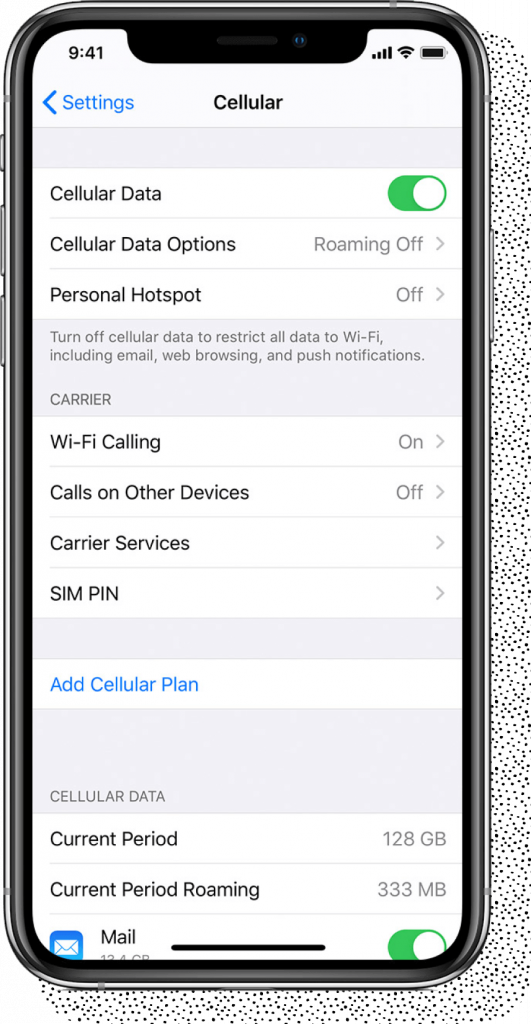
iPhones, iPads und iPods haben alle die gleichen Einstellungen, da sie auf iOS laufen.
However, some Apple devices automatically use Wi-Fi connections. iMessage is a popular messaging service that uses this. Users connect to the internet to send and receive text messages rather than cellular data. These messages still come from your U.S. number, so your recipients won’t know the difference.
The only difference? This only happens when texting an Apple device from another Apple device. If an iPhone texts a Google or Samsung phone, iMessage won’t be supported. The message will be sent as a normal text through a cellular connection.
Weiterlesen: Die 11 besten drahtlosen VoIP-Telefonoptionen für 2020 (Wi-Fi & DECT)
So aktivieren Sie WLAN-Anrufe auf Android-Telefonen
Können Sie immer noch Wi-Fi-Anrufe tätigen, wenn Ihr Gerät das Android-Betriebssystem verwendet? Jawohl!
Um WLAN-Anrufe auf Ihrem Android-Gerät zu aktivieren, gehen Sie zu Ihren Einstellungen. Klicken Sie auf die Schaltfläche Netzwerk & Internet. Klicken Sie dann auf WLAN-Einstellungen und tippen Sie auf Erweitert:
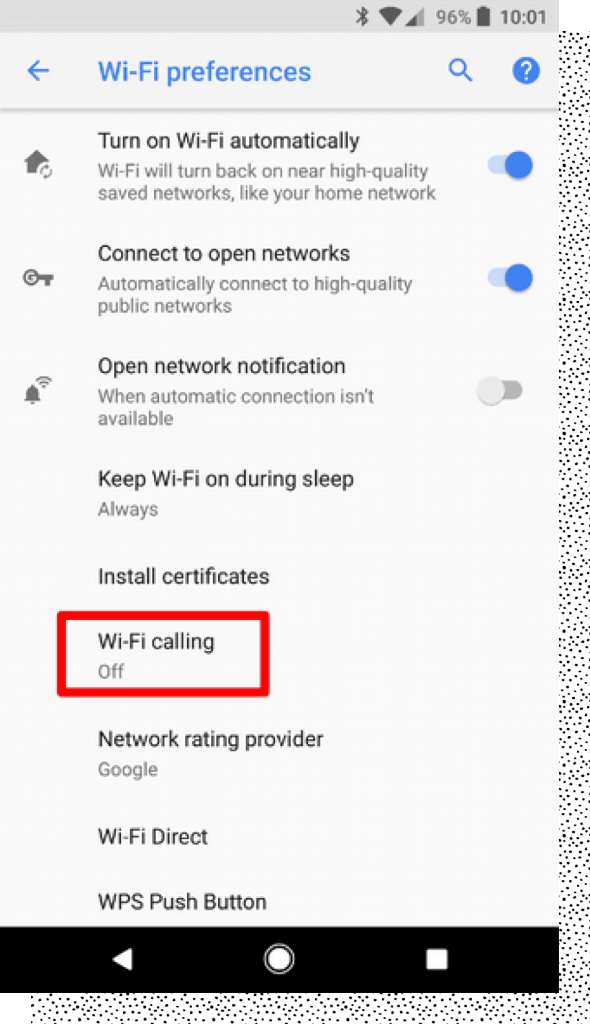
Here, you’ll see a toggle for Wi-Fi calling. Switch the button to On:
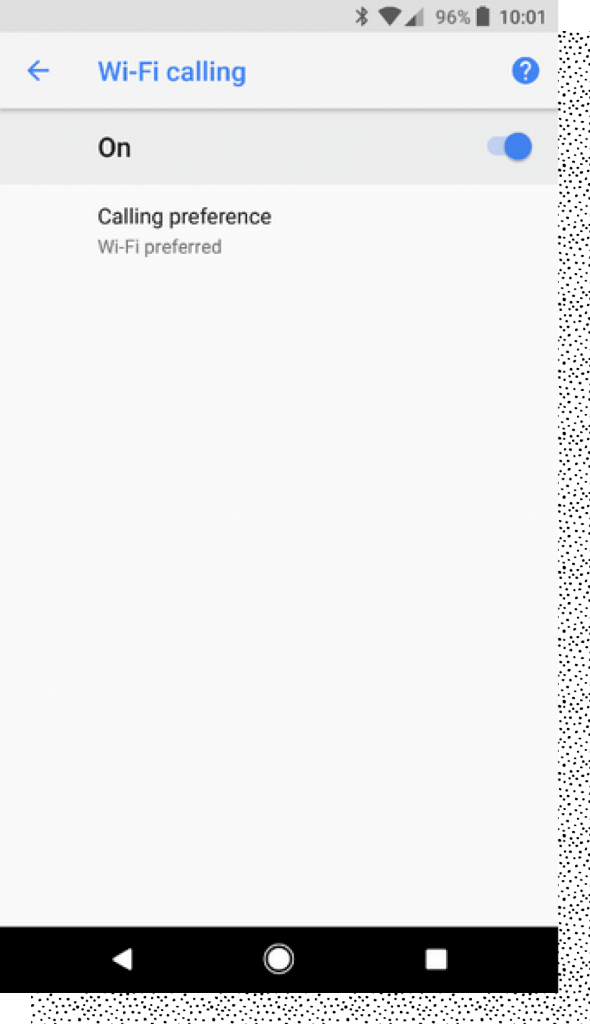
You’ll then need to turn off your standard mobile phone data. You can do this by turning your Android phone to Airplane Mode.
Der Flugmodus verhindert, dass sich Ihr Gerät auf die Nutzung mobiler Daten verlässt. Ein- und ausgehende Anrufe werden automatisch über Wi-Fi getätigt.
What’s the Difference Between Cellular Data and Wi-Fi Calling?
Wi-Fi calling allows you to speak to people in remote locations. You don’t need to be near a cellphone tower. You simply need an internet connection. However, providers like AT&T, T-Mobile, and Verizon supply mobile data—so long as you’re near one of their towers.
Wi-Fi kann jedoch eine schwächere Verbindung haben als Mobilfunkdaten. Die Sprachqualität kann beeinträchtigt werden, wenn viele Personen gleichzeitig den WLAN-Hotspot nutzen. Dies geschieht normalerweise an überfüllten Orten wie Einkaufszentren oder Stadien.
Ein Nachteil von Wi-Fi-Anrufen ist, dass es unter anderem Störungen durch Ihr Netzwerk ausgesetzt sein kann VoIP-Probleme. Diese Probleme sind vermeidbar, aber Sie können Echos oder Verzögerungen haben, wenn Sie eine fehlerhafte Netzwerkverbindung haben.
Videoanrufe, die über Wi-Fi getätigt werden, können darunter leiden. Aus diesem Grund ist es möglicherweise nicht die beste Option für entfernte Mitarbeiter stuck in airports with an overcrowded Wi-Fi connection. They’d probably have a stronger cellular connection. That’s because cellular coverage areas are reliable in urban areas.
And if that wasn’t enough, Wi-Fi calls could verlängern Sie Ihre Akkulaufzeit. A device that continuously searches for a cellular network to connect to can drain your battery. A device using Wi-Fi calls doesn’t. It simply connects to one network—and stays there until you disconnect.
Häufig gestellte Fragen
1) Wie tätige ich Wi-Fi-Anrufe mit Nextiva?
You can make Wi-Fi calls using Nextiva’s VoIP-App. Head over to your App Store and search “Nextiva” to download the app to your device. (Note that you might need an Enterprise account to use the app.)
Laden Sie zunächst Ihre Kontakte in die Datenbank hoch. Sie können dies tun, indem Sie Kontakte von Ihrem Gerät importieren oder sie manuell hinzufügen.
Dein VoIP Telefonnummer will be the same one created when you got your Nextiva subscription. The same applies if you’re using an international number.
Then, when you’re done, hit the Call tab towards the bottom of your screen. Click the person you want to call.
If you’ve already enabled Wi-Fi calling on your device, the Nextiva call won’t use your cellular data. It will jump on the wireless internet connection you’re already using.
2) Kann ich weiterhin Notrufe tätigen?
Anrufe über mobile Daten werden für Notrufe bevorzugt. Warum? Denn wenn ein Mobilfunkanruf getätigt wird, pingt er nahegelegene Mobilfunkmasten an. Die Rettungsdienste verwenden diese Daten, um Ihren Standort zu verfolgen und Ihren Anruf an die nächstgelegene Notrufzentrale oder PSAP weiterzuleiten.
Davon abgesehen können Sie in einer Notsituation immer noch Wi-Fi-Anrufe tätigen, aber stellen Sie sicher, dass Sie dem Betreiber Ihren genauen Standort mündlich mitteilen.
3) Kann ich eine Adresse für mein Telefon registrieren, um Wi-Fi-Anrufe zu tätigen?
Emergency services can’t easily track a caller’s location from Wi-Fi calls. For this reason, you’ll need to add an address to your device. This is used if you einen Notruf tätigen. Die Polizei (oder andere) wird an diesen Ort geschickt, wenn Sie sie über ein Wi-Fi-Netzwerk anrufen.
The device you’re using will ask for an emergency address when you enable calls over Wi-Fi. For cell phone carriers, it’s typically your billing address. The Nextiva App will automatically draw your emergency address from your User Profile. You can’t use this feature without adding this information to your Apple or Android device.
4) Welche Arten von Geräten können Wi-Fi-Anrufe tätigen?
Immer mehr Telefonanbieter unterstützen Wi-Fi-Anrufe, darunter:
- AT&T
- Verizon
- T-Mobile
- Sprint
- Cloud-Telefonsysteme
Fast alle Android- und Apple-Telefone unterstützen jetzt Wi-Fi-Anrufe.
Alternativ können Sie die verwenden Nextiva Business-App to make work-related Wi-Fi calls. You can sync your work phone’s contact list to the app. Then, you can use the app to make high-quality phone calls over your Wi-Fi.
But what if you’re using a device that doesn’t have a cellular connection, anyway? The Nextiva App is also compatible with Windows and Mac operating systems. This means you can make Wi-Fi-Anrufe über Ihren PC. You don’t need your mobile device.
Regardless of which device you’re using, you can still make a call using a Wi-Fi connection.
5) Wie schalte ich es aus?
Not ready to start using Wi-Fi for your calls? Don’t worry. You can still switch back to using your cellular network at any time.
To do this, head back to the Wi-Fi settings for your device. Simply switch the toggle back to Off. For Android devices, you’ll also need to switch off airplane mode in your status bar. Apple users will need to turn their cellular data back on through their settings menu.
You can switch between Wi-Fi and cellular calls at any time. For example, if you’re working remotely and don’t have good signal strength, use Wi-Fi calls. But if you’re in the office with a strong cellular connection, stick to that.
6) Ist es sicher?
When making a call, your mobile carrier encrypts your voice. This happens when you’re using a Wi-Fi connection, making such calls perfectly safe — even if the Wi-Fi network isn’t secure or password-protected.
7) Vor- und Nachteile
- Vorteile: Data is taken from your existing mobile plan, without any extra charges. Plus, you don’t need any extra hardware—just an internet-connected device. And, since calls are encrypted, they’re perfectly safe for business use. Wi-Fi calls can also save your device’s battery.
- Nachteile: It’s a relatively new technology. Therefore, some mobile carriers and handsets don’t support Wi-Fi calls.
It’s the way forward for remote and mobile staff
Wi-Fi calls are a great alternative to cellular calls. You don’t need a device containing a SIM card, nor be close to a cellular mobile network tower, to make a phone call.
Dies macht Wi-Fi-Anrufe zu einer perfekten Option für mobile oder Remote-Mitarbeiter. Unabhängig davon, wo auf der Welt sie sich befinden, können sie ohne zusätzliche Kosten zu Ihrem Büro in den USA zurückrufen. Außerdem können sie auf die springen Cloud-Telefon even if they’re in the middle of nowhere.
Once you set your preferred calling connection to Wi-Fi, there’s no looking back.
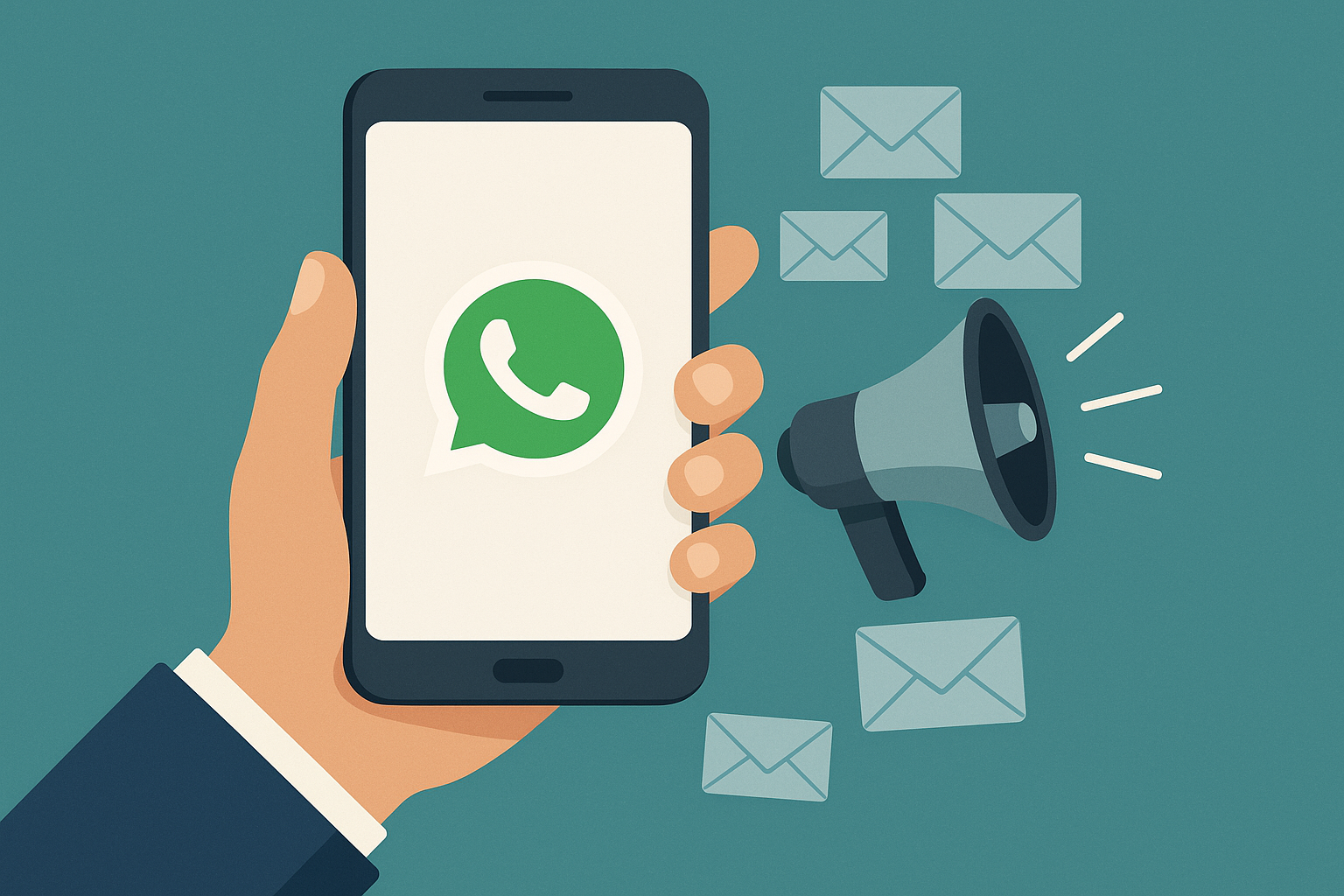



Diese Seite funktioniert, und es besteht kein Zweifel, dass sie sehr bald für ihre hochwertigen Inhalte berühmt sein wird.